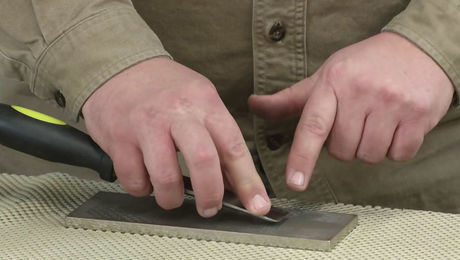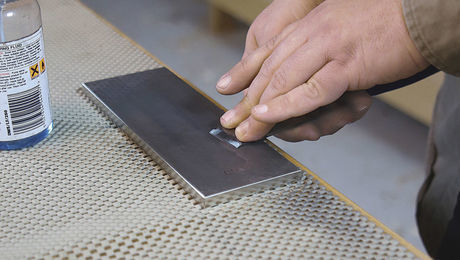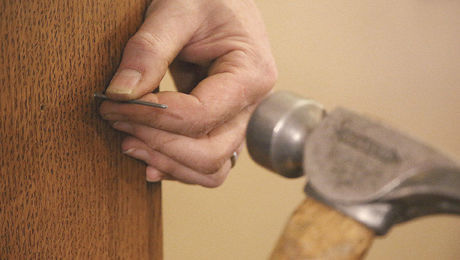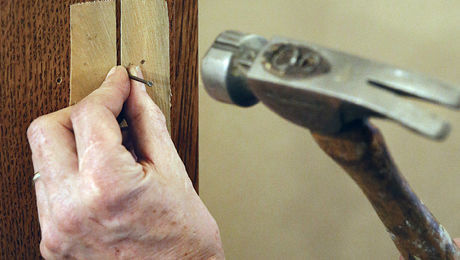Framing Rough Openings for Prehung Doors
Framers Larry Haun and Scott Grice demonstrate how to set trimmers so that shims are unnecessary.
You can set a door without any shims simply by setting your trimmers properly. Take your level, and place it on the trimmer. If level, take 8d nails, and toe-nail it at the bottom of the trimmer. Place nails on both sides. Check that it is level. Using a stool, nail the trimmer at the top.
Knowing that the first trimmer is level, use a spacer for the next. The space is 33-1/2 in. long. It allows you to set a 32-in. door with a 3/4-in. jamb on each side. Cut the trimmers an extra 1/8 in. so that they fit in tight and stay in position. Pull the trimmer over to the spacer, and nail it in place.
Straighten the trimmers with a long level. Pull the trimmer out a little bit if it is uneven using the claw end of a hammer.
Clipping the door will allow it to stay in place before the drywall goes up without having to use shims. Drive an 8d nail into the king stud. Bend it over to the trim, and trap it with another nail bent into the trim.
Cut out the bottom plate using a Sawzall or a flush-cutting saw. The only thing lacking in the opening now is drywall backing. A piece of wood cut to the width of the door opening needs to be nailed at door height for drywall backing. This is how the cripple is eliminated. By placing the piece of wood at door height, the doors have been properly framed. Once the drywall is in, the prehung door can be slipped in.
Watch Larry Haun and Scott Grice’s previous videos on wall framing:
- 3 Tips for Laying Out Studs on Wall Plates
- 6 Tips for Spreading Wall Plates on a Subfloor
- The Top 10 Tips for Wall-Framing Layout on a New Subfloor
Other Related Links:






























View Comments
This old guy is a super Hacker extraordinaire!
Really nice to watch the old school guys. They make everything look so easy
Been framing for about 40 years...I feel like I'm watching my dad when he taught me. Atta boy..
I love when guys like bobtb snipe at Larry. It shows their ignorance of who Larry is and what he has contributed to modern framing techniques.
Why would you build an opening with no space for your door to be adjusted you have to cram it in there? That seems ignorant to me.
Larry mention on is doors opening that was for pre-hung doors they come with some kind of pre-installed trim around them for nailing if you leave to much room you will be nailing them in the void of your over-size hole even modern framer can learn allot from a guy like Larry just check is roof building skills video ...
I love watching Larry swat 16d nails with rhyme and reason. There is a purpose to his every motion and an efficient pace towards completing the project.
The step where you use the Sawzall to cut out the bottom plate and move it up to the top of the door to be used as a nailer: it will be loose by the thickness of two Sawzall blades. Is that in any way a problem?
I agree with larry that every trimmer needs to be level and plumb. I check every one right after I plumb and line the rough frame. I also toe-nail two eights into the floor on each side of the bottom plate after removing the floor plate from the opening. I want to make sure the floor plate is on the line along the floor. The problems I see with not shimming the jamb is that it leaves you no out when the door shop delivers the doors with hinge screws that are deeper than the jamb material. This is very common on exterior doors. I also noticed that many doors are hinge bound straight out of the door shop. If you give yourself room to shim the hinge and jamb you can usally cure the problem on-site. I also notice that rockers rarely hold the sheetrock back from a opening and tapers love to clean their knife's off in doorways. If I am shimming the opening I usally only have to file or trim the rock or mud at the shims. While I'm not quite as old as larry I have hung thousands of doors in my 35 years of carpentry and know your not always working behind the cleanest framers in the world. it takes me just about the same amount of time to fully shim a door as it took to float the trimmers in that video. One last thought I hope Larry never has to remove one of his trimmers to get a little extra room for a custom door that got orderd as an after thouht...he'll have to call the taper back to patch the rock over the door.
The only comment I have at this juncture is that I like to purchase as dry lumber as possible. Sometimes this means spending more money for good indoor kept studs and covering my door openings with plastic. I know we can't weather but everylittle helps-other than that I loved the video.
Thanx
Creebomb
I am a firm believer in shimming doors within a rough opening which allows some options for out-of-plumb framing or a twisted/crooked stud. I appreciated the effort spent plumbing and straightening the opening, but there are no guarantees that the opening will be in that condition by the time the finisher arrives on sight. While this may work well for Larry, I would not recommend this method. Sorry.
Lets see your video bobtb.